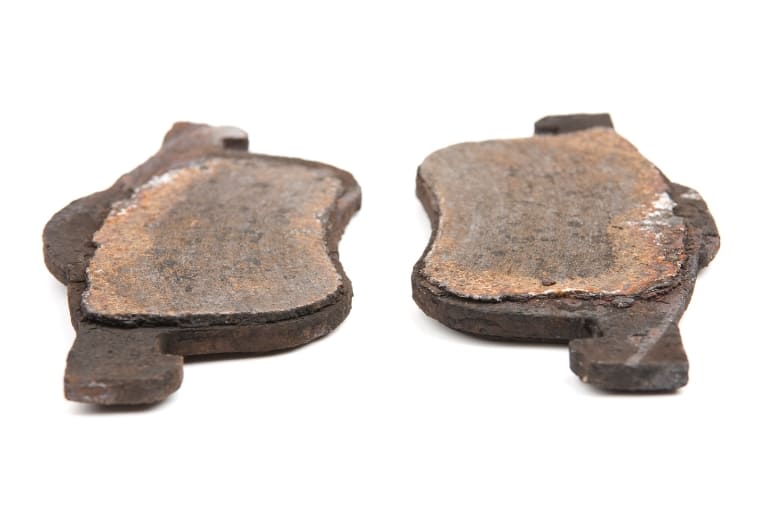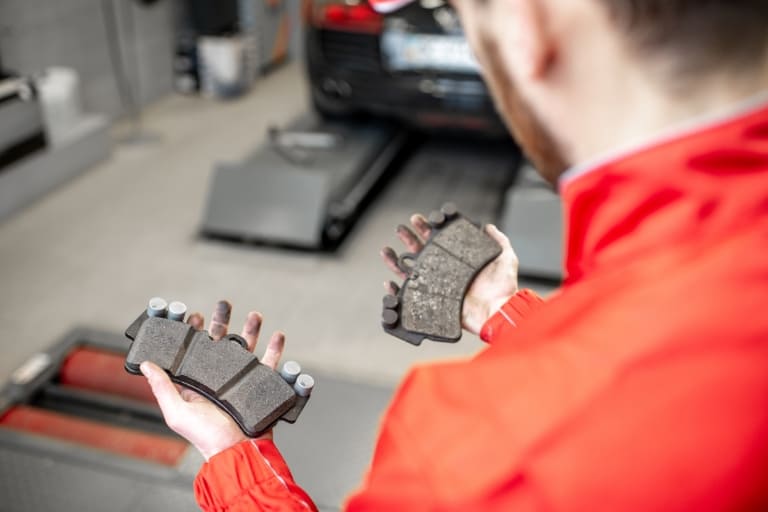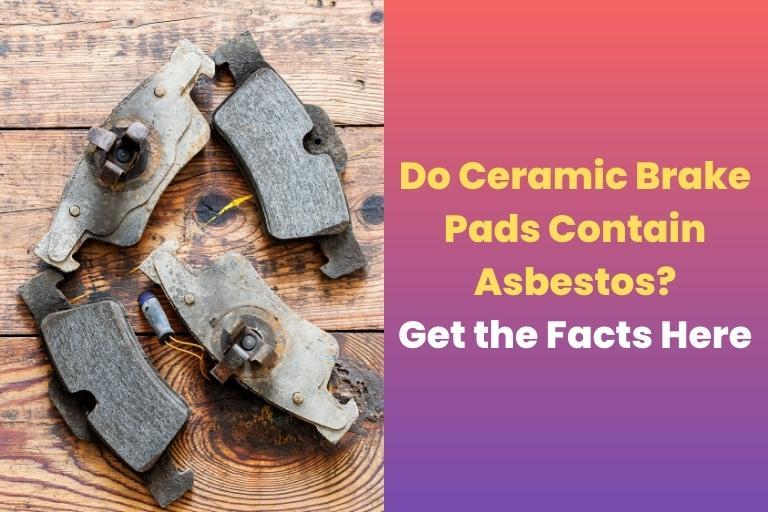Ceramic brake pads are a popular choice for many car owners. However, some people have expressed worry over whether these brake pads contain asbestos, a dangerous chemical that may cause major health problems like; lung cancer, mesothelioma, and other respiratory ailments.
In this blog, we will investigate whether ceramic brake pads contain asbestos, what are modern brake pads made of, which brake pads contain asbestos, how to check if your brake pads have asbestos, and are ceramic brake pads better than asbestos.
After reading the blog, you will better grasp and comprehend the brake pads. So, without further ado, let’s get right into the topic.
Disclaimer: Please remember we are not healthcare experts; our experience and expertise is limited to providing automotive information. However, we feel it is essential to inform our readers that asbestos is harmful to health. We have included some links to reports and studies to support our content. If you have any questions about the health risks of asbestos, we encourage you to visit these Links.
- Link 1: https://www.gao.gov/assets/t-hrd-88-20.pdf
- Link 2: https://www.cancer.gov/about-cancer/causes-prevention/risk/substances/asbestos/asbestos-fact-sheet
Contents
Do ceramic brake pads contain asbestos?
NO. Asbestos is not present in ceramic brake pads. Because of the negative effects of asbestos on human health and the environment, the car industry has changed to non-asbestos brake pads to comply with federal laws. The only way ceramic brake pads could contain asbestos is if they were purchased on the illegal market.
Why do ceramic brake pads not contain asbestos Nowadays?

Present-day brake pads don’t include them because of their hazardous effects. There is also plenty of other reasons why asbestos is not used. A few of the reasons are discussed below:
Asbestos particles become entrapped in the brake housing.
When you push your brakes, friction between the brake pads and the rotor generates a lot of heat. Asbestos was earlier used in brake pads because it could absorb heat. With more development in science and research, it has now been discovered to be hazardous to human health and the environment.
Asbestos fibers are tiny and can break off from brake pads and spread as dust throughout the braking system. This dust consists of microscopic, light particles that can migrate inside the brake housing. The housing is a long insulated cable with one end open.
Asbestos dust particles can enter the housing through the aperture and become stuck, obstructing the route. This can affect the braking system’s operation and constitute a health concern if you are exposed to dust when performing maintenance or replacing brake pads. As a result, brake pad makers have turned to employing synthetic materials, such as ceramic, that do not contain asbestos to assure safety.
Housing Federal law against asbestos
In the United States of America, federal laws govern and limit the use of asbestos in several states. However, the federal government established legislation prohibiting it because of its negative influence on human health.
According to normal regulation, it is harmful and not authorized under the Toxic Substances Control Act. According to the TSCA standards, it cannot be used in any vehicle component that may have an impact on human beings.
Furthermore, the federal statute integrates with the 1986 Asbestos Hazard Emergency Response statute. With tightened rules, brake pad producers cannot incorporate this antiquated technology into their manufacturing processes.
Due to violations, the US government can take harsh measures against manufacturing businesses and terminate their licenses. Due to suspended licenses, many enterprises cannot continue production procedures, affecting their company and causing losses.
Toxic for environment
Asbestos is not only hazardous to human health, but it is also hazardous to the environment. Microfibers and airborne particles can be discharged into the air during the repair or replacement of asbestos brake pads, polluting the environment.
Although asbestos is heat-resistant and does not burn at high temperatures, it can deteriorate over time owing to environmental causes, releasing microscopic, lightweight particles into the air. These particles can travel large distances and pollute the environment.
When asbestos fibers are breathed, they can linger in the lungs for a long time and cause major health concerns such as lung cancer and respiratory disorders. Furthermore, owing to pollution, they might cause skin rashes and irritation. Inside the human body, they can break down further and cause even more health problems.
For example, they can combine with air and sulfate to generate an aerosol, which can induce asphyxia and erratic breathing. As a result, using asbestos in brake pads is now prohibited to safeguard both human health and the environment.
Banned import and reduced brake performance
Because of its toxicity, asbestos has been prohibited from being used in the manufacture of brake components since the late 1990s. In 1989, the Environmental Protection Agency prohibited asbestos imports, and the government curtailed its import and use. A few corporations have attempted to skirt the rules, but the government has made efforts to enforce the restriction.
Asbestos usage in brake components can diminish braking performance. Asbestos dust can build up over time, making braking components harsh and inefficient.
This can result in uneven surfaces on the calipers and rotors, excessive vibrations, and friction, which can cause serious braking system failure. Furthermore, the dust from asbestos brake pads can build on the wheels, limiting their efficiency and posing safety risks. As a result, using non-asbestos brake pads is now the standard, providing superior vehicle performance and safety.
More use of Non-asbestos brake pads
Because of the toxicity and environmental risks connected with asbestos brake pads, a transition toward non-asbestos brake pads has occurred. These brake pads often blend synthetic and organic materials, such as rubber, Kevlar, and ceramic fibers.
Non-asbestos brake pads provide several advantages over asbestos brake pads. They are more robust, endure longer, and are heat-resistant, making them ideal for high-performance automobiles. Furthermore, they produce less dust, resulting in a cleaner and safer driving experience.
The introduction of non-asbestos brake pads has also reduced environmental pollutants significantly. They emit fewer pollutants during manufacture and disposal, and their use has contributed to lower air and water pollution levels.
Furthermore, non-asbestos brake pads are typically quieter than asbestos brake pads, frequently making a screeching noise when applied. This improves the driving experience for both the driver and the passengers.
Noise during pressure braking
Asbestos is no longer utilized in ceramic brake pads because it can produce loud sounds when under strain. It comprises materials that absorb moisture and avoids friction, but it is not robust enough to withstand large loads and eventually wears out.
When the braking system is used, sounds might be heard within the vehicle. As the pads wear down, they emit a large amount of dust particles into the air. This dust can also accumulate on other sections of the brake system that are subjected to pressure during braking, causing further wear and tear.
Also, Check: Brake Shuddering After New Rotors and Pads
What are modern brake pads made of? Do they use asbestos?

Modern brake pads are constructed of several materials, none including asbestos. Depending on the manufacturer’s inclination and the intended usage of the brake pad, brake pads are often constructed from a combination of metallic, organic, and ceramic components.
Compared to previous choices, modern brake pads have various compositions owing to their manufacturing material. They are semi-metallic, with a few exceptions being metal-based. They also include copper, iron, and graphite.
Their manufacturing ingredient, iron, enhances their longevity. They are heavier and thicker due to their metallic nature.
They are more heat resistant than organic pads. They can also resist high loads and survive for thousands of kilometers. They are more resistant to braking system fade than the alternatives.
Because of their endurance and quiet operating conditions, they are more dependable. Copper, brass, and graphite are common materials used in contemporary brake pads.
Furthermore, they contain a clip that may separate the rotor and pad. The clip has a cooling effect and minimizes heat levels and other sounds.
Which brake pads contain asbestos?
Asbestos was once widely utilized in brake pads. However, it is no longer used in brake pads manufactured or marketed in the United States. However, certain older automobiles, particularly those made before the 1990s, may still have asbestos-containing brake pads. If you own an older car, consult a technician or brake specialist to determine whether your brake pads contain asbestos.
It’s also worth noting that certain nations may still permit the use of asbestos in brake pads, so if you’re going on an overseas trip, it’s a good idea to investigate the legislation of the countries you’ll be visiting.
How do I know if my brakes have asbestos?
Because the use of asbestos in brake pads has been outlawed in many countries, including the United States, if your automobile was made after 1990, your brake pads are unlikely to contain asbestos. However, your brake pads might contain asbestos if you have an older car.
Testing your brake pads by a skilled technician or brake expert is the best method to determine if they contain asbestos. They can take a sample of the material and examine it to see if asbestos fibers are present.
Are ceramic brake pads better than asbestos?
Yes. Ceramic brake pads are typically thought to be superior to asbestos brake pads. Because it could tolerate heat and friction, asbestos was formerly a popular material for brake pads. Still, it was shown to be detrimental to human health, causing respiratory difficulties and even cancer.
On the other hand, ceramic brake pads can sustain greater temperatures without fading or losing stopping strength, making them an attractive option for high-performance cars. They also generate less dust and noise than other brake pads, which helps keep your wheels and tires cleaner and improves overall driving comfort.
In addition to being safer and more effective, ceramic brake pads have a longer lifespan than asbestos brake pads. They may be more expensive up front, but they can save you money in the long term by lowering the frequency with which brake pads must be replaced.
Related Articles, You May Like:
- Brake Pads Not Touching the Whole Disc
- How Close Should Brake Pads Be To Rotors?
- Does the Emergency Brake Lock All Wheels?
- Can You Spray Brake Cleaner on Brake Pads?
- Can You Use Front Brake Pads on The Rear?
- Why Does My Car Shake After Changing the Brake Pads?
- How to Install Anti-Rattle Clips on Brake Pads
- Is it safe to drive without Brake Pads?
- How Long Do Brake Pads Last
- Fixing New Ceramic Brake Pads Making a Grinding Noise
- Ceramic vs. Semi-Metallic Brake Pads: Which is Better?
- Why Are My Brakes Grinding After New Pads And Rotors
- Ceramic vs OEM brake pads
- Ceramic vs Organic Brake Pads
- Ceramic vs Carbon Fiber Brake Pads: A Comprehensive Comparison
Conclusion
In conclusion, asbestos brake pads are no longer utilized in automobiles due to the potential health risks of asbestos fiber exposure. Instead, depending on the manufacturer’s desire and the intended function of the brake pad, brake pads are currently created from a range of materials, including ceramic, metallic, and organic materials.
Ceramic brake pads are a popular choice among car owners since they outperform asbestos brake pads in performance, durability, and safety. They can endure greater temperatures without fading or losing stopping power, generate less dust and noise, and last longer.
If you own an older car, get your brake pads tested by a specialist to see whether they contain asbestos. If they do, they should be handled and disposed of by a professional who has received asbestos-related material handling training.
Overall, investing in high-quality brake pads comprised of safe and durable materials such as ceramic will assist in assuring your vehicle’s safety and dependability on the road. Regular brake maintenance and inspections are also necessary to keep your brakes in good working order and to avoid accidents.
